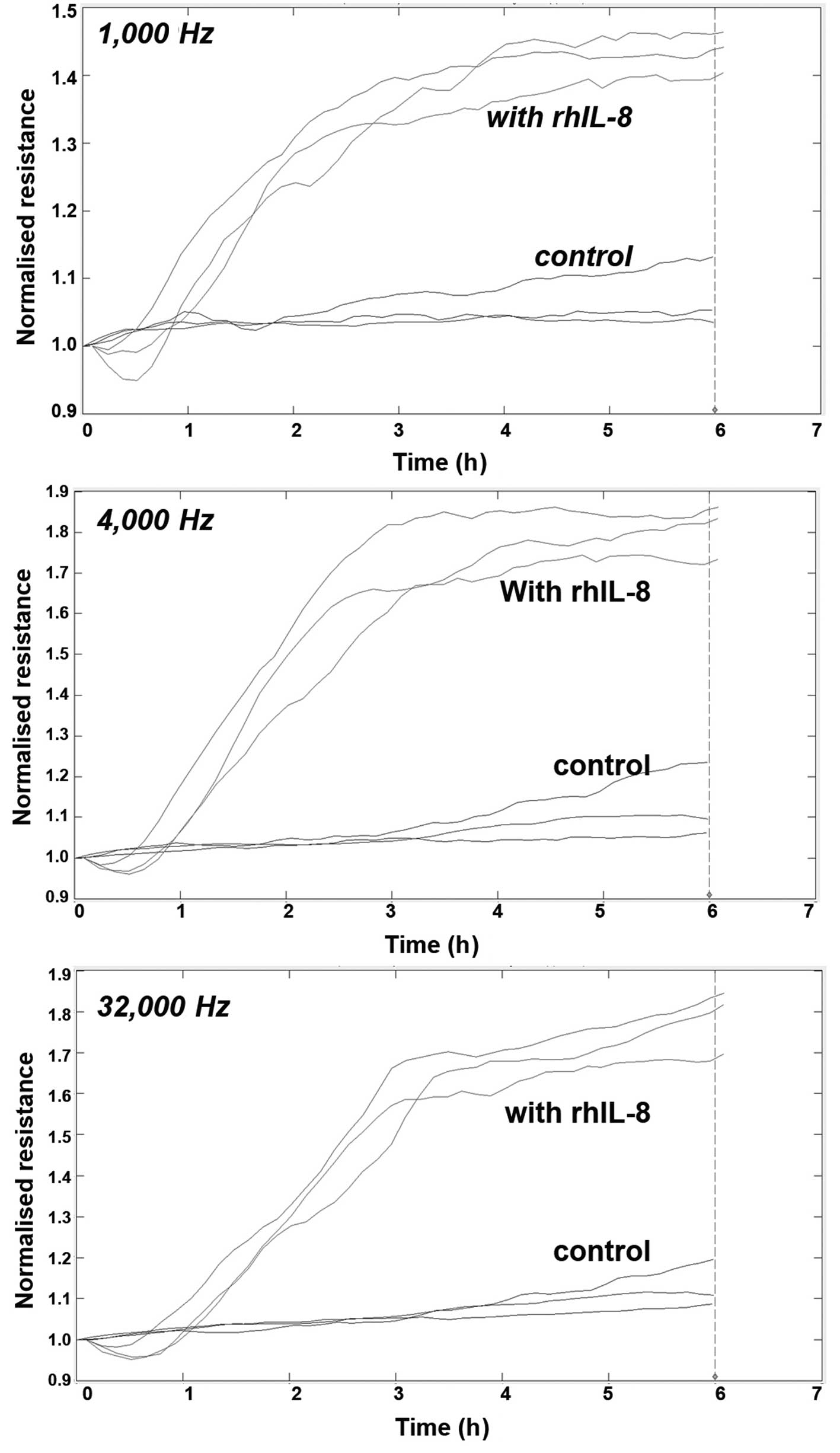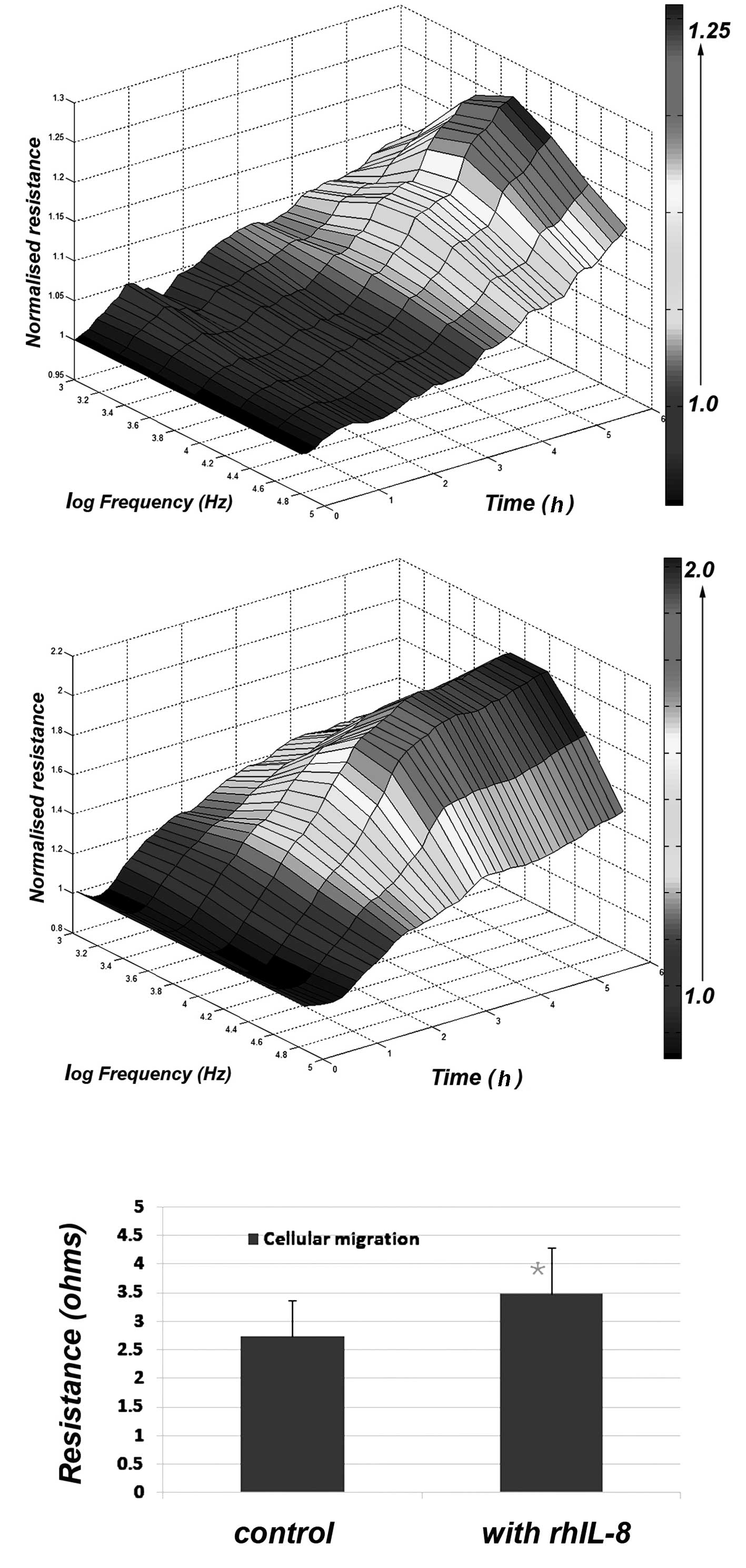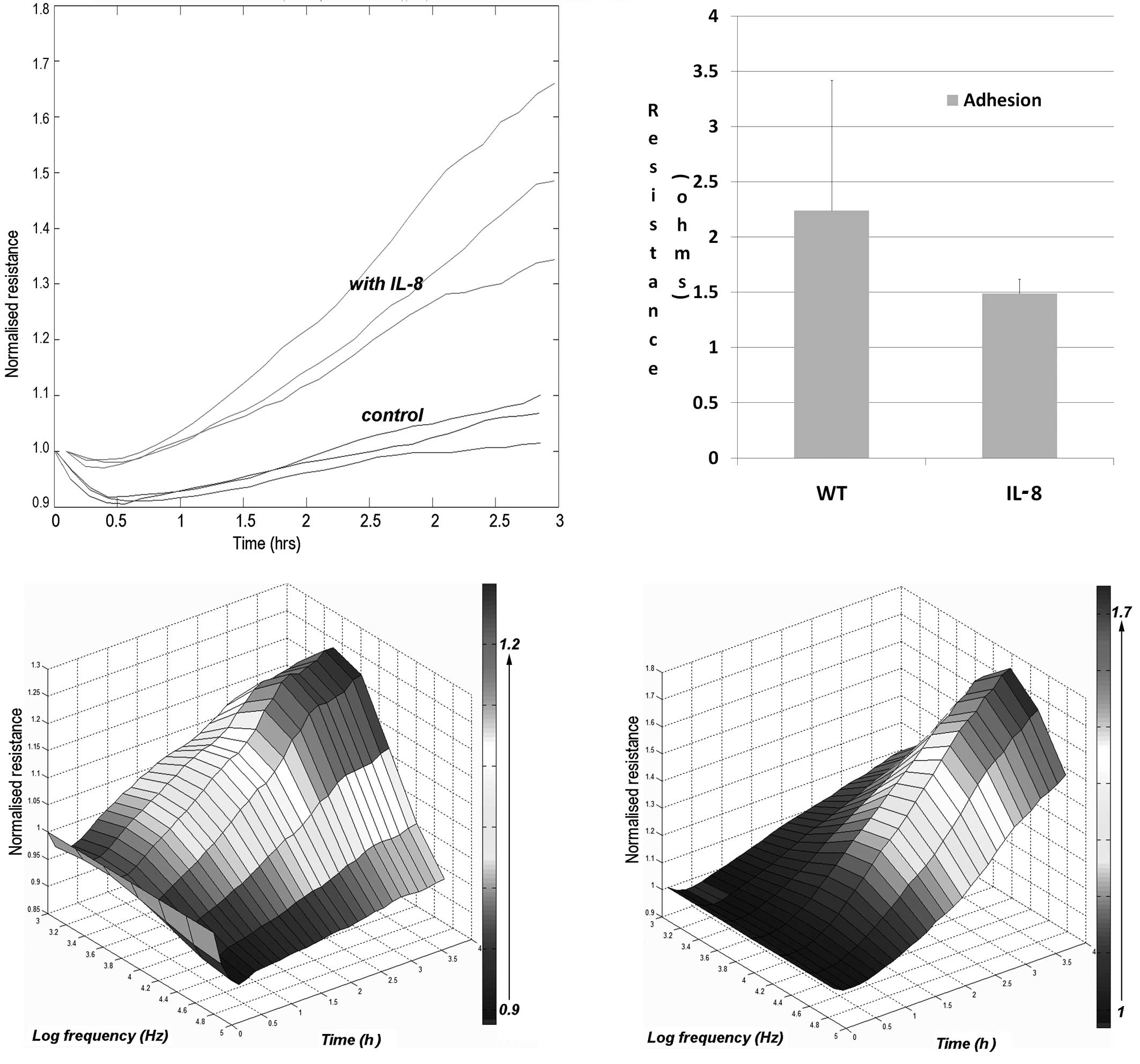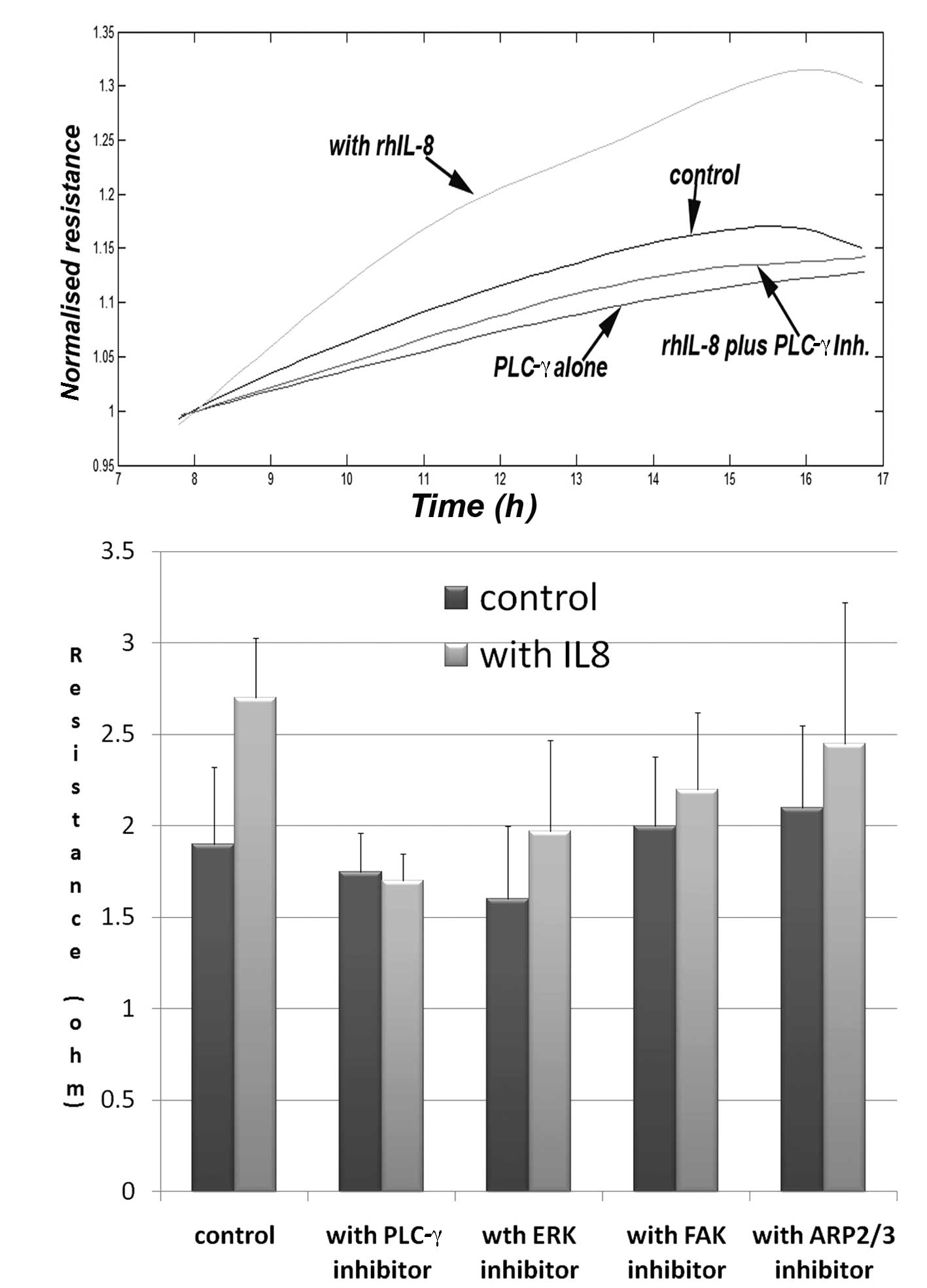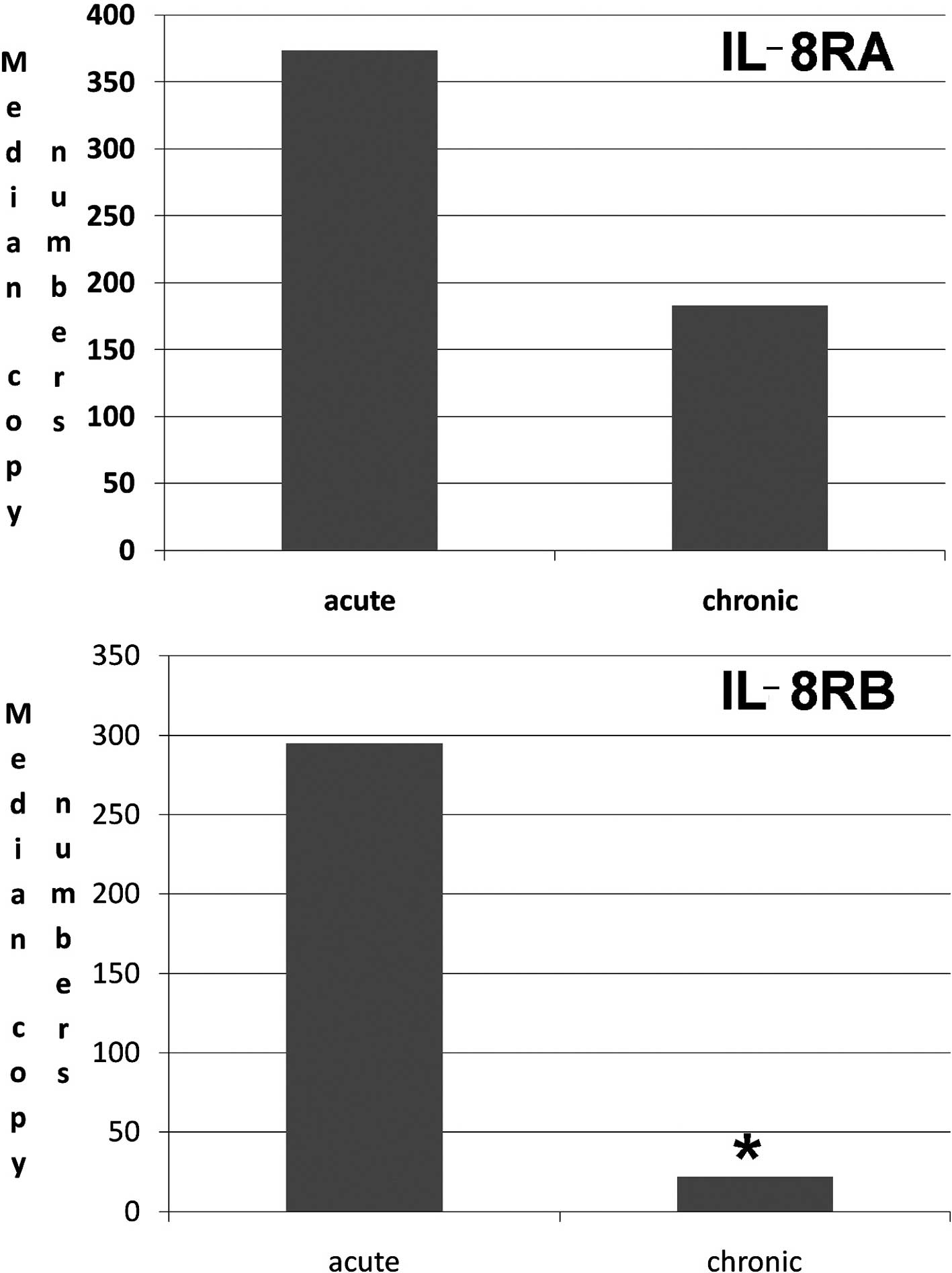Influence of interleukin-8 (IL-8) and IL-8 receptors on the migration of human keratinocytes, the role of PLC-γ and potential clinical implications
- Authors:
- Published online on: December 1, 2011 https://doi.org/10.3892/etm.2011.402
- Pages: 231-236
Abstract
Introduction
Interleukin (IL)-8, also known as neutrophil activating peptide, CXCL8, small inducible cytokine subfamily B (SCY88) and granulocyte chemotactic protein-1 (GCP-1), is a cytokine that belongs to the CXC chemokine family (1,2). IL-8 is a small protein that is encoded by the IL-8 gene, which is located on chromosome 4q12-q21 (3). IL-8 has been shown to be linked to a number of conditions including viral bronchiolitis (4–6), cystic fibrosis related pathophysiology of the lungs, infection and other inflammatory diseases, including rheumatoid arthritis (7). It plays a pivotal role in the pathophysiology of sepsis. IL-8 is a powerful chemoattractant for neutrophils, basophils and T cells, but not monocytes, although the latter is a rich source of IL-8.
The action of IL-8 is mediated by its receptor, IL-8R. IL-8R has two forms, IL-8RA and IL-8RB. IL-8RA is also known as chemokine, CXC motif, receptor-1 (CXCR1), or IL-8R1. IL-8RA is located on chromosome 2q35 (8,10). IL-8RB is also known as chemokine, CXC motif, receptor-2 (CXCR2) or IL-8R2 (8,9), and is located on chromosome 2q35. In the body, monocytes and fibroblasts are rich sources of IL-8. It was recently reported that the healing of diabetic and non-diabetic leg ulcers following treatment with Lactobacillus plantarum, increased such that, to a certain degree, it coincided with the increase in the IL-8 production of the polymorphonuclear cells in the wound base (11). It has also been shown that IL-8 has an impact on the migration of fibroblasts and endothelial cells.
IL-8 has been found to be highly stained in keratinocytes (12). Keratinocytes increased the expression of IL-8 in response to inflammatory stimuli such as tissue plasminogen activator (tPA) (13). Other agents, include trypsin, which increases and salbutamol, which inhibits the production of IL-8 from keratinocytes (14). Gingko biloba extract also inhibits IL-8 secretion from keratinocytes (15). IL-8RA and IL-8RB have been found to be present in keratinocytes of the skin. IL-8 and IL-8R have also been shown to be co-expressed in gingival keratinocytes (16). In psoriasis, IL-8R has been found to be overexpressed in keratinocytes, which may be inhibited by FK-506, an anti-psoriasis compound (17).
The potential role of IL-8 as a cell migration and chemotaxis factor indicates a significant role in wound healing. Indeed, it has been demonstrated that IL-8 may be chemotactic for human keratinocytes, which express IL-8Rs (18). In animal models using IL-8RB knockout mice, there was a delayed rate of wound healing (19). This appears to be associated with a delay in monocyte recruitment to the wounding space and a delay in re-epithelialisation and angiogenesis.
The impact of IL-8 and the IL-8R in the context of chronic wounds and clinical wound healing have otherwise not been well investigated. Chronic wounds represent a major health issue. Derived from multiple aetiology, including diabetes mellitus, pressure sores and circulation conditions, chronic wounds are costly to treat for the healthcare system. For example, in the UK, there are approximately 200,000 patients with chronic wounds at any given time, the care of which consumes more than 3% of the budget of the NHS. However, the biology of wound healing and, in particular, chronic wound healing are not yet fully understood. Wound healing is a complex biological process that requires temporal, special and co-ordinated action of multiple cell types, including immune cells for combating possible pathogens, fibroblasts for matrix deposition and remodelling, endothelial cells for the angiogenic process and keratinocytes for re-epithelialisation. IL-8 appears to play multiple roles in these processes.
In the present study, we investigated the transcript expression of IL-8RA and IL-8RB in a cohort of human wound tissues, and report the significant link between the cytokine complex and the fate of the wound. Furthermore, we have shown that IL-8 has a direct effect on the migration of human keratinocytes.
Materials and methods
Cells and tissues
The human keratinocyte cell line, HaCaT, was purchased from the German Cancer Institute and routinely maintained in Dulbecco’s Modified Eagle’s Medium (DMEM), supplemented with 10% fetal calf serum (FCS) and antibiotics. A cohort of fresh, frozen human wound tissues, acute wound tissues (n=10) and chronic wound tissues from venous ulcers (n=14), were collected under an Ethics Approval from clinics in the University Hospital of Wales, and used for histology and gene expression analysis, as previously reported (20,21).
Recombinant human IL-8 (rhIL-8) was obtained from NBSB (Potters Bar, England, UK). Antibodies to human IL-8RA and IL-8RB were from Santa Cruz Biotechnologies Inc. (Santa Cruz, CA, USA). ERK inhibitor II (FR180204) and PLC-γ inhibitor (U73122) were purchased from Calbiochem (Merck Chemicals Ltd, Nottingham, UK). FAK inhibitor was from Tocris (Bristol, England), and Arp2/3 inhibitor was from Chemidiv Ltd (San Diego, CA, USA).
Tissue processing and preparation of materials for protein and molecular investigations
Tissues were frozen and sectioned on a Leica cryostat at 5–10 μM thickness. The sections were divided into two portions: one section was processed for histological investigation and the other for extraction of genetic materials. For histological analysis, sections were laid on slides, prior to fixing and blocking by hydrogen peroxide and methanol. The section was then processed for H&E staining.
A large number of frozen sections were combined and homogenised using a homogenizer in a RNA isolation buffer (Triagent; Sigma-Aldrich, Poole, Dorset, UK). Total RNA was subsequently separated and quantified using a spectrophotometer.
Quantitative analysis of IL-8RA and IL-8RB transcripts in cells and tissues
Total RNA was extracted from cell pellets using Triagent obtained from Sigma-Aldrich. Fresh frozen wound tissues were combined, resuspended in Triagent and homogenised using a hand-held homogeniser (Fisher Scientific). Total RNA was extracted and purified from the cells and tissue sections according to manufacturer’s instructions. Equal amounts of RNA were reverse transcribed into complementary DNA (cDNA) using a first-strand reverse transcription (RT) kit from Bio-Rad (Hemel Hemstead, UK). For quantitative analysis of the IL-8R transcripts, we employed a real-time quantitative PCR assay, as previously reported (22–24). Briefly, primers (sequences shown in Table I) were designed using the Beacon Designer software and satisfied the following criteria: the amplified region sits on an exon-exon joint region and is specific to the respective target; the amplicon is smaller than 150 bp; a sequence that was complementary to the probe was added to one of the primers (routinely the reverse primer); and the annealing temperature is, or is close to being, 55°C. The Ampliflor Uniprimer system was used as the probe system. cDNA from cells and tissues, together with a set of standards were amplified simultaneously, on a IcyclerIQ5 system (Bio-Rad). The concentration of the respective transcript was calculated from the standard curve, which was simultaneously generated. The levels of the transcripts are shown here as the respective transcript/glyceraldehyde 3-phosphate dehydrogenase (GAPDH) ratio.
Electric cell-substrate impedance sensing (ECIS)-based cell adhesion and cell migration assays
ECIS Ztheta and 96W1E arrays were used (Applied Biophysics Inc, Troy, NY, USA) (23,25,26). Following treatment of the array surface with a cysteine solution, the arrays were incubated with complete medium for 1 h. The same number of HaCaT cells were added into each well, with or without IL-8 and small inhibitors. Cell adhesion was recorded immediately following addition of the cells, at multiple frequencies, for up to 6 h. For the cell migration assay, confluent HaCaT cells with or without IL-8, and small signalling inhibitors, were wounded for 20 sec at 6 V. The migration of the cells was immediately traced following wounding for up to 18 h, again with multiple frequencies. Cell behaviour was modelled using the Rb method, using a cell-free well as a reference unit. Cell migration and adhesion are shown here as the change in resistance.
Statistical analysis was carried out using Minitab. For normality test, the Anderson-Darling test was used, and for statistical differences the Student’s t-test and Mann-Whitney U test were used as appropriate.
Results
IL-8 markedly increased the migration of keratinocytes
Using electrical wounding methods, we first tested the impact of rhIL-8 on the migration of HaCaT cells following wounding. As seen in Fig. 1, IL-8 markedly increased the migration of the cells (Fig. 1).
Using 3-D cellular modelling, the differences between control and IL-8-treated cells were clearly visible (Fig. 2) with the maximum effects observed at a frequency of 4,000 Hz. This difference was statistically significant (p<0.01) (Fig. 2).
IL-8 had a significant effect on the adhesion of keratinocytes
We further tested to see whether IL-8 had an effect on the adhesion of keratinocytes to the matrix. Again, using the ECIS attachment method, we evaluated the rate of cell adhesion. As shown in Fig. 3, the presence of IL-8 markedly increased the adhesion of the cells.
Potential signalling pathways in the action of IL-8
In order to explore potential pathways involved in the aforementioned action, we used a panel of small inhibitors to some of the known pathways downstream of the IL-8R. We have demonstrated that the PLC-γ inhibitor markedly inhibited the increased migration induced by IL-8, and brought the migration to the control level. The same inhibitor has an inhibitory effect on cell adhesion, although this is yet to reach significance (data not shown). The ERK inhibitor also had an inhibitory effect on the migration of keratinocytes, but did not completely eliminate the action of IL-8. The FAK and ARP2/3 inhibitors had marginal effects (Fig. 4).
Human chronic wound tissues had a marked low level of IL-8RB
We investigated the transcript levels of the IL-8Rs, IL-8RA and IL-8RB in acute and chronic wound tissues. As shown in Fig. 5, there were significantly lower levels of IL-8RB in chronic wound tissues than in acute tissues (Fig. 5). Although the levels of IL-8RA tended to be lower, this was not statistically significant.
Discussion
The present study reports that the status of the IL-8R, IL-8RB, is linked to clinical outcome in chronic wounds. Furthermore, this study further demonstrates that IL-8 has a direct impact on the migration of human keratinocytes.
We show that IL-8 has a profound effect on the migration of keratinocytes. It has previously been shown that IL-8 may act as a chemoattractant to keratinocytes, in that keratinocytes may respond to the gradient change of IL-8. In the present study, we used a novel method, ECIS, and an electrical wounding model. In this model, cells were wounded by an electric current, and the migration of cells from the surrounding areas was traced in the prescence of IL-8. The data presented here, therefore, clearly indicate that IL-8 also induces migration, most likely in the form of chemokinesis, of keratinocytes, another crucial form of cell migration.
CXC chemokine-induced chemotaxis involves a number of intracellular signalling pathways, classically the JAK, Src/PI3K, FAK and PLC pathways (27–30). The present study clearly demonstrates that the IL-8-induced migration of HaCaT cells (chemokinesis) critically requires the PLC-γ pathway, in that the PLC-γ inhibitor suppressed IL-8-induced migration and completely blocked the action of IL-8. By contrast, FAK, ARP2/3 and ERK inhibitors do not appear to signficantly affect the action of IL-8.
It has previously been shown that IL-8 is associated with wound healing in vivo (19). In an IL-8RB knockout mouse model, it was found that the rate of wound healing was reduced, thought to be the result of a reduction in monocyte recruitment to the wounding space, reduced angiogenesis and re-epithelialisation. In this study, we provide further evidence that IL-8 itself has a direct impact on the re-epithelialisation of keratinocytes.
Despite the evidence, in vitro and in vivo, that IL-8 and IL-8Rs have an impact on wound healing, it is not known how the IL-8Rs are linked to the healing of human wounds. The present study provides first-line evidence that in chronic wounds, the levels of IL-8RA and, in particular, IL-8RB are significantly lower when compared with acute wound tissues. This is noteworthy, as it indicates that a loss or reduction of IL-8Rs may be an essential part of the mechanisms of why wounds are not healing or responding to IL-8. It is highly plausible that the low levels of IL-8Rs rendered cells necessary for wound healing irresponsive or poorly responsive to IL-8, a cytokine that appears to be involved in the wound healing process. Together with in vitro data and evidence from animal studies, it is suggested that IL-8 and IL-8Rs are a useful indicator for the nature of healing of a given wound. This further suggests that IL-8 may be a means to manipulate the healing of wound tissues and may have a therapeutic value. This is likely to be manifested by the direct effect of IL-8 on keratinocytes, on endothelial cells, through the induction of angiogenesis, on immune cells for combating infection and fibroblasts during the tissue modelling process of wound healing. Of course, IL-8 is not at all a clear wound healer without concerns. It has been shown that IL-8RB may mediate skin carcinogenesis when overexpressed or repeatedly induced (30).
In conclusion, IL-8 has a profound impact on keratinocytes by increasing the rate of cell migration. Together with the observation that IL-8Rs are markedly lower in chronic than in acute wounds, it is suggested that IL-8 and its receptors have prognostic and therapeutic value in difficult-healing wounds.
Acknowledgements
The authors wish to thank Dr Kevin Conway for his help in the collection of tissues. The authors also wish to thank the Welsh Government (A4B programme), Cardiff Partnership Fund, Cancer Research Wales and Albert Hung Foundation for their support.



